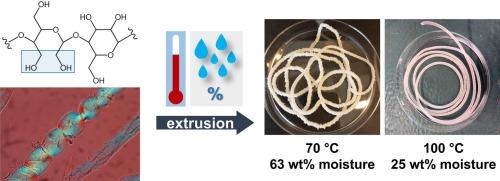仅用水作为增塑剂对化学改性纤维素纤维进行熔融加工:水分含量和加工温度的影响
IF 10.7
1区 化学
Q1 CHEMISTRY, APPLIED
引用次数: 0
摘要
要想用纤维素纤维替代石油衍生聚合物,最好能选择熔融加工。然而,在加热过程中,纤维素通常会在材料达到软化温度之前开始降解。塑料替代品最好还能通过现有的回收流进行回收。在这里,我们要解决的问题是如何在熔融加工纤维素纤维的同时保持其可回收性。将原生纤维素纤维部分改性为二羟基纤维素,以赋予其热塑性特征。我们展示了仅用水作为增塑剂对这些改性纤维进行熔融加工的过程。在选定的加工温度和初始含水量下,通过监测挤出机螺杆的轴向力作为流变指标,对加工性能进行了研究。核磁共振光谱、显微镜、拉伸测试、纤维形态分析和 X 射线衍射分析了对分子结构、纤维形态和材料特性的影响。将熔融加工挤出物与手板进行比较,本已非常出色的延展性得到了进一步提高。拉伸强度和刚度略有下降,原因是结晶度下降和纤维缩短。这是第一份使用纤维素纤维作为唯一原料生产出坚固耐用的挤出物的报告。最后,还证明了通过纸张回收程序将加工过的材料与未改性纤维一起回收利用的潜力。本文章由计算机程序翻译,如有差异,请以英文原文为准。

Melt processing of chemically modified cellulosic fibres with only water as plasticiser: Effects of moisture content and processing temperature
To replace petroleum-derived polymers with cellulose fibres, it is desirable to have the option of melt processing. However, upon heating, cellulose degradation typically starts before the material reaches its softening temperature. Alternatives to plastics should also, ideally, be recyclable via existing recycling streams. Here, we address the problem of melt processing cellulose as fibres while preserving recyclability. Native cellulose fibres were partially modified to dialcohol cellulose to impart thermoplastic characteristics. We demonstrate melt processing of these modified fibres with only water as plasticiser. Processability was investigated at selected processing temperatures and initial moisture content by monitoring the axial force of the extruder screws as a rheological indicator. The effects on molecular structure, fibre morphology and material properties were characterised by NMR spectroscopy, microscopy, tensile testing, fibre morphology analysis and X-ray diffraction. When comparing the melt-processed extrudate with handsheets, the already exceptional ductility was further increased. Moderate losses in tensile strength and stiffness were observed and are attributable to a loss of crystallinity and fibre shortening. This is the first report of strong and durable extrudates using cellulosic fibres as the only feedstock. Finally, the potential for recycling the processed material with unmodified fibres by paper recycling procedures was demonstrated.
求助全文
通过发布文献求助,成功后即可免费获取论文全文。
去求助
来源期刊

Carbohydrate Polymers
化学-高分子科学
CiteScore
22.40
自引率
8.00%
发文量
1286
审稿时长
47 days
期刊介绍:
Carbohydrate Polymers stands as a prominent journal in the glycoscience field, dedicated to exploring and harnessing the potential of polysaccharides with applications spanning bioenergy, bioplastics, biomaterials, biorefining, chemistry, drug delivery, food, health, nanotechnology, packaging, paper, pharmaceuticals, medicine, oil recovery, textiles, tissue engineering, wood, and various aspects of glycoscience.
The journal emphasizes the central role of well-characterized carbohydrate polymers, highlighting their significance as the primary focus rather than a peripheral topic. Each paper must prominently feature at least one named carbohydrate polymer, evident in both citation and title, with a commitment to innovative research that advances scientific knowledge.
 求助内容:
求助内容: 应助结果提醒方式:
应助结果提醒方式:


